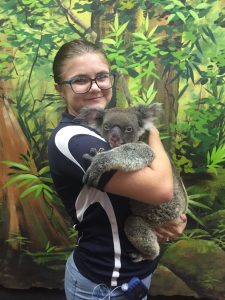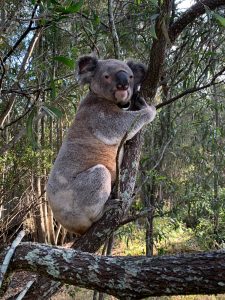

Jade Fernance, a PhD student at the University of Queensland has been provided a grant to assist in her PhD project involving Koalas. The grant will be used to assist in her work focusing on wild koala conservation through the assessment of reproductive biology utilising faecal biomarkers.
INTRODUCTION
The koala (Phascolarctos cinereus) is an arboreal, marsupial folivore, native to Australia, and the sole remaining extant member of the Phascolarctidae family. The value of the koala as an important cultural symbol for Aboriginal communities is portrayed through numerous creation stories and the use of the koala as a totem of spiritual significance. The koala continues to be ecologically influential due to its inherent value as a flagship species for lesser researched marsupials; this species also serves as an excellent research model due to their relatively adaptive and passive nature and their availability in large numbers within zoological institutions in South-east Queensland, allowing for the collection and assessment of both invasive (e.g. blood plasma and physical examination) and non-invasive (e.g. behavioural observation and faecal or urinary samples) parameters for the evaluation of health and reproductive function. Koalas within South-east Queensland are currently exhibiting evidence of catastrophic population declines, being listed as vulnerable with a decreasing population trend within the IUCN Red List, and vulnerable to extinction within Queensland, New South Wales and the Australian Capital Territory. There is a high probability that the rate of koala population decline has been greatly exacerbated by the 2019-2020 bushfire season, with an excess of 10 million hectares burnt, including areas of crucial koala habitat required for the continuation of the species. Therefore, koala conservation and management remain essential for the wellbeing and ongoing success of this species’ longevity. One method of koala population assessment that is greatly underutilised for conservation measures is the non-invasive assessment of reproductive physiology in both captive colonies (used for maintaining a genetic resource bank), and wild populations (to assess wild breeding potential, seasonality, and the effects of rehabilitation/temporary captivity on reproductive potential). An understanding of the physiology associated with koala reproduction is essential for continued improvements into captive breeding strategies and to assess fecundity in wild populations. Throughout the duration of this project, the non-invasive analyses of extracted hormones, assayed via enzyme immunoassay (EIA) will be established, validated and conducted using captive koalas (Dreamworld and Currumbin Wildlife Sanctuary (CWS)) to determine whether it is possible to use these techniques to assess the reproductive statuses of wild koala populations within South-east Queensland without the need for the capture or restraint of individual animals. The expected outcomes from research into these non-invasive biomarkers that are anticipated to benefit koala conservation physiology include: 1) the characterisation and mapping of the koala oestrous cycle, pregnancy and early lactation, 2) the determination of the age of sexual maturity and seasonality for this species, 3) providing insight into the reproductive patterns of wild koalas in temporary captivity, whilst maintaining minimally invasive measures, and 4) the application of faecal hormone analysis to non-invasively determine the sex and reproductive status of unknown koala individuals, in an attempt to work towards wild koala population assessments. Without the crucial information provided by research into this field, methods of increasing wild koala reproductive function will remain unassessed, thus limiting the potential for improvements to the currently utilised conservation strategies. Through the incorporation of non-invasive reproductive analysis within wild koala population assessments, it will be possible to identify and evaluate the available options for increasing reproductive output whilst maintaining a strong genetic pool for the future generations of wild koalas; research into this field of study may ultimately improve the chances of saving the koala species from continued population declines, poor genetic diversity and eventual extinction. Future applications of non-invasive analysis of koala faecal pellets, in addition to the endocrine analysis of reproductive hormones, includes the measurement of glucocorticoids, thyroid hormones, genetic analysis, disease determination and microbiome analysis. Through the incorporation of multiple aspects of faecal analysis, it may be possible to establish a wide spectrum of reproduction, health and population analysis techniques, to further improve the management and conservation of wild koala colonies within Australia.
Primary research aim: To describe in detail the faecal reproductive physiology of the male and female koala and apply this knowledge to the non-invasive assessment of captive and wild koala reproduction.
METHODS
All procedures described within this proposal have been approved through the UQ Animal Ethics Committee. The current AEC Approval Number is as follows: SAFS/250/17.
Study 1: Validate the use of faecal hormone analysis for the quantification of biologically relevant levels of previously unassessed faecal reproductive hormones in the koala, using EIA techniques. This will involve analysis of (a) faecal samples collected from adult female koalas in various stages of the reproductive cycle (e.g. pregnant, behavioural oestrus, parturition and early lactation (n = 14)), (b) the effects of freeze-thaw cycles on the stability of faecal hormone metabolites (n = 10 data sets) and (c) the effects of time and temperature on the stability of faecal hormone metabolites (n = 10 data sets). We currently have a successfully validated EIA for progesterone and testosterone metabolites, but we would like to now test and validate oestrogen and prostaglandin F2 alpha assays.
Study 2: Characterise the koala oestrous cycle, pregnancy, early lactation, and the return of oestrus after pregnancy and weaning through the EIA of daily faecal samples, analysed for reproductive metabolites (oestrogens, prostaglandin F2 alpha, and progestogens) in pregnant lactating (n = 14), mated non-pregnant (n = 10), and non-mated (n = 8) females.
Study 3: Apply faecal hormone analysis to assess captive female (n = 8) and male (n = 8) koala seasonality, through the analysis of faecal oestrogens and androgens collected weekly, in association with observations of behavioural and physical indicators of reproductive activity. Additionally, we will attempt to evaluate the onset of sexual maturity in weaned juveniles (n = 8 males; n = 8 females) through the comparison of behavioural observations, in addition to EIA analysis of temporal changes in faecal oestrogens, and androgens, collected twice weekly.
Proof of concept studies: (a) Apply faecal hormone analysis to assess the successes and failures of wild koala reproduction throughout a period of temporary captivity and upon release into wild habitats, through the collection and EIA evaluation of thrice weekly faecal samples from wild male (n = 6) and female (n = 6) koalas housed at the Koala Breeding Centre (KBC) at Dreamworld, and opportunistically from wild environments once released. (b) EIA assessment of reproductive hormones (oestrogens, prostaglandin F2 alpha, progestogens and testosterone) in faecal samples (n = 10 males; n = 10 females) obtained through blind faecal sample trials at Currumbin Wildlife Sanctuary to determine whether it is possible to use this data to non-invasively determine the sex and reproductive status of individual animals, working towards the assessment of wild populations.
Faecal sample collection, processing and enzyme immunoassay procedures: Faecal samples will be collected from koalas, housed at either a) Dreamworld, or b) CWS. Samples collected from captive animals have already been collected from when the koala was opportunistically seen to defecate, was individually housed, or through direct cloacal stimulation. Faecal samples will be homogenised and dried overnight at 65-75 °C. Dried faecal samples weighed at 0.20 ± 0.01g will be mixed with 5 mL of 80% MeOH rotated overnight. Following overnight extraction, vials will be centrifugated for 10 min at 1000g, and the supernatant decanted into 6 mL scintillation vials and kept at -20°C until analysis. Faecal samples will undergo EIA analysis, utilising both in-house EIA procedures (where possible) and pre-purchased Arbor Assays EIA kits. The validation of faecal hormone analysis for oestrogens and prostaglandin F2 alpha will be conducted through both laboratory assay-based validation (the demonstration of parallelisms between serially-diluted, pooled faecal extracts and the respective standard curves) and biological validation (evaluating the change of hormones during biologically relevant validation events such as oestrus, pregnancy, and lactation). Assay antisera to be validated includes: 1) oestradiol metabolites – components shipped from the Rupert Palme laboratory, Vienna, 2) Oestriol metabolites – components shipped from Coralie Monroe, UC Davis laboratory, and 3) Prostaglandin F2 alpha metabolites – Arbor Assays Detect X 13, 14-dihydro-15-keto-PGF2a (PGFM) Enzyme Immunoassay kit.
Tracking and faecal sample collection from wild-captive (KBC) koalas: Wild koalas currently housed at Dreamworld Australia for temporary captivity for use within the Advanced Queensland Innovation Partnership (AQIP): ‘A Living Koala Genome Bank’ project (AQIP00715-16RD1) shall be assessed for their suitability for release into pre-selected wild environments. During temporary captivity for breeding purposes, koalas will have faecal samples collected thrice weekly, for a period of up to 12 months to assess the effects of the transition from wild to captivity on reproductive function and pregnancy success. Prior to release each koala will enter into a soft-release area for a minimum of three weeks and will be fitted with a modified LiteTrack 60 collar with radio frequency communication so as to allow daily tracking and opportunistic faecal collection once released into wild habitats for approximately five months, dependant on individual animal requirements.
Blind faecal sample trials: Faecal samples shall be collected on one occasion by CWS staff from captive koalas, group housed in outdoor enclosures (n = 10 males, n = 10 females). Faecal samples will be collected from an individual koala, with sex and reproductive status known to CWS (e.g. male or female, cycling, mated, lactating, juvenile), and each koala shall be given an identification number, so that knowledge pertaining to sex and reproductive status may remain unknown by the researcher, but may be obtained after the analysis of reproductive hormones.
Data analysis: Data analysis will be conducted using the free to download R studio package (statistical coding software) for the longitudinal analysis of hormone data. This software was created with the purpose of aiding wildlife endocrinologists in the assessment of temporal and longitudinal data sets, through the accurate calculation of baseline values, and variations from baseline (peaks or elevations), in addition to a range of general statistical analysis such as ANOVA, and Welch’s t-tests.
SCHEDULE
Year 1 (2019): Daily faecal sample collection from captive and KBC female koalas, weekly faecal sample collection from captive and KBC male koalas, and twice weekly faecal sample collection from captive juvenile koalas, housed at Dreamworld. Regular recording of biologically relevant reproductive events for comparative analysis with EIA data. Release and monitoring of three KBC koalas into wild habitats for application case study.
Year 2 (2020): Continuation of faecal sample and biologically relevant data collections from female, male and juvenile koalas at Dreamworld. Release and monitoring of three KBC koalas into wild habitats. Conduction of laboratory-based EIA experiments at the University of Queensland’s Wildlife Endocrinology laboratory. Faecal drying, weighing and extraction of all available samples. Validation of faecal oestrogen and prostaglandin F2 alpha metabolite assays. Analysis of all Dreamworld koala samples for progestogens and testosterone metabolites. Analysis and writing of publications for validation studies, laboratory experiments and progestogen and testosterone EIA analysis.
Year 3 (2021): Analysis of all Dreamworld koala samples for faecal oestrogen and prostaglandin F2 alpha metabolites. Blind faecal sample trials at CWS, including analysis. Analysis of all KBC koala, faecal samples (from captivity and post-release), and any samples requiring further analysis. Presentation of research findings at suitable conferences (ie. Australian Mammal Society and International Society of Wildlife Endocrinology). Complete writing PhD thesis, publication of papers detailing the application of faecal hormone monitoring for conservation purposes, and submission of final report to CWRT.